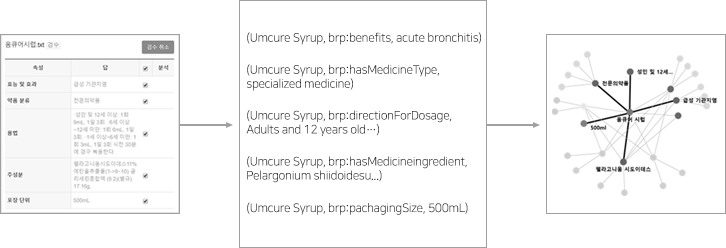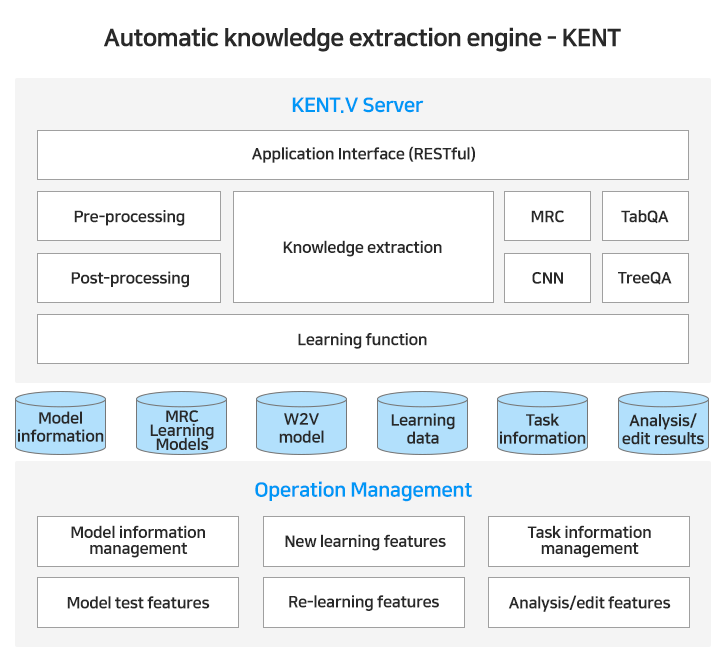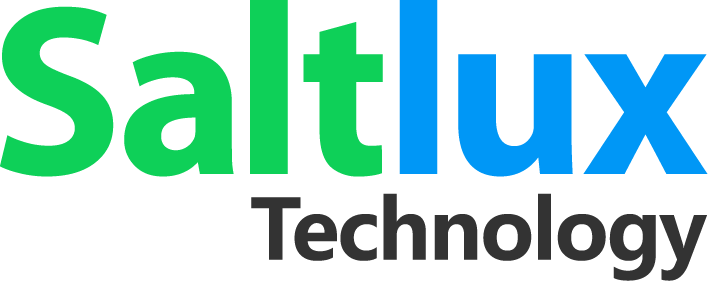Knowledge learning Engine KENT
Saltlux’s AI Suite Knowledge Extraction from Natural Language Text (KENT) extracts from structured and non-structured data; learns and manages dialogue processing. The automatic knowledge extraction engine can extract useful knowledge information from product manuals, contracts, etc.

< Knowledge extraction and knowledge graph generation example >
Main Features
- Ensemble AI-based high-precision knowledge extraction
The knowledge learning engine applies ensemble AI technology in which rule-based knowledge extraction and deep learning-based knowledge extraction are combined to extract knowledge from documents. In general, knowledge extraction has low extraction accuracy rates. Therefore, to overcome the limitations, a large-scale knowledge graph, inference technique, and deep learning algorithms are combined to provide a high level of performance in real-world services.
- An automatic large-scale knowledge generation and validation
The knowledge learning engine can be linked with the knowledge graph, which allows the extracted knowledge to be converted into a graph form. This extraction and conversion process can be automated to generate a large amount of knowledge from large-volume documents or to quickly extract and validate knowledge from data entered in real-time.
- Flexible application according to various data types
The knowledge learning engine can generate knowledge extraction models for both modified structured/semi-structured documents, such as HTML code, table data, modified forms, and unstructured documents such as manuals or news articles. Based on the applicability of the document type, users can customize various types of documents in various domains, such as finance, law, and medicine.
Main features and specifications
The engine consists of KENT Server, which is responsible for knowledge extraction via knowledge learning feature, and the operation management server, which allows learning models and tasks to be managed on the web.

< Knowledge learning engine system construction >
- Automatic knowledge extraction task management feature
The engine provides an automatic knowledge extraction task management feature in which knowledge extraction can be learned from various types of knowledge resources on one system. System users can create and register various automated knowledge extraction tasks according to their goals, as well as manage learning models for each task.
- Knowledge extraction feature
The knowledge learning engine extracts knowledge from documents based on learning models. If the knowledge learning engine extracts knowledge from documents based on learning models. Suppose the extracted knowledge needs to be linked to a knowledge graph. In that case, it will identify the objects in the document and connect them to existing knowledge graph objects or creates new objects in the knowledge graph. It identifies relationships between objects created based on contextual information and provides features to learn these processes.
- Knowledge extraction results supervision feature
If the input document is not reflected in the knowledge extraction result or if the extraction result is wrong, it provides an inspection feature to correct the result or add unextracted knowledge. The supervision results are reflected in the knowledge learning model, influencing subsequent documents’ knowledge extraction results, thus allowing continuous quality improvement.
- Knowledge learning generation and management feature
The knowledge learning engine maThe knowledge learning engine uses learning tools to manage neural network models for knowledge extraction. It also provides features for learning, applying, and testing.
- Automatic knowledge extraction model evaluation feature
It provides a feature to evaluate whether the model created for automatic knowledge extraction performs the extraction accurately. The model evaluation feature allows the user to verify the accuracy of the automated knowledge extraction model and perform model optimization.
Main engine screen

< Automatic knowledge extraction model evaluation >< Knowledge extraction results supervision >

< Knowledge extraction feature > < Knowledge learning model generation and management >



